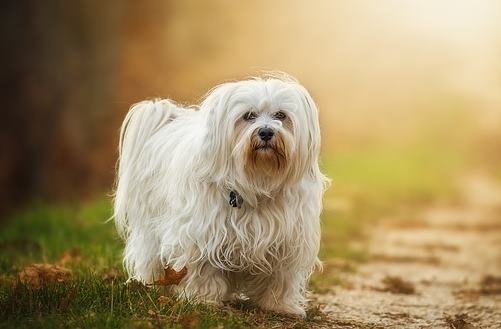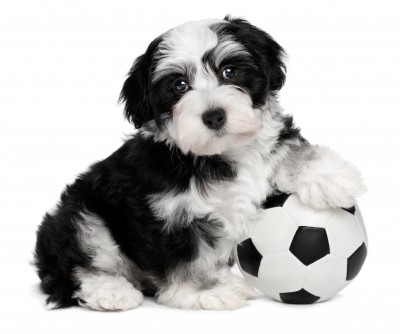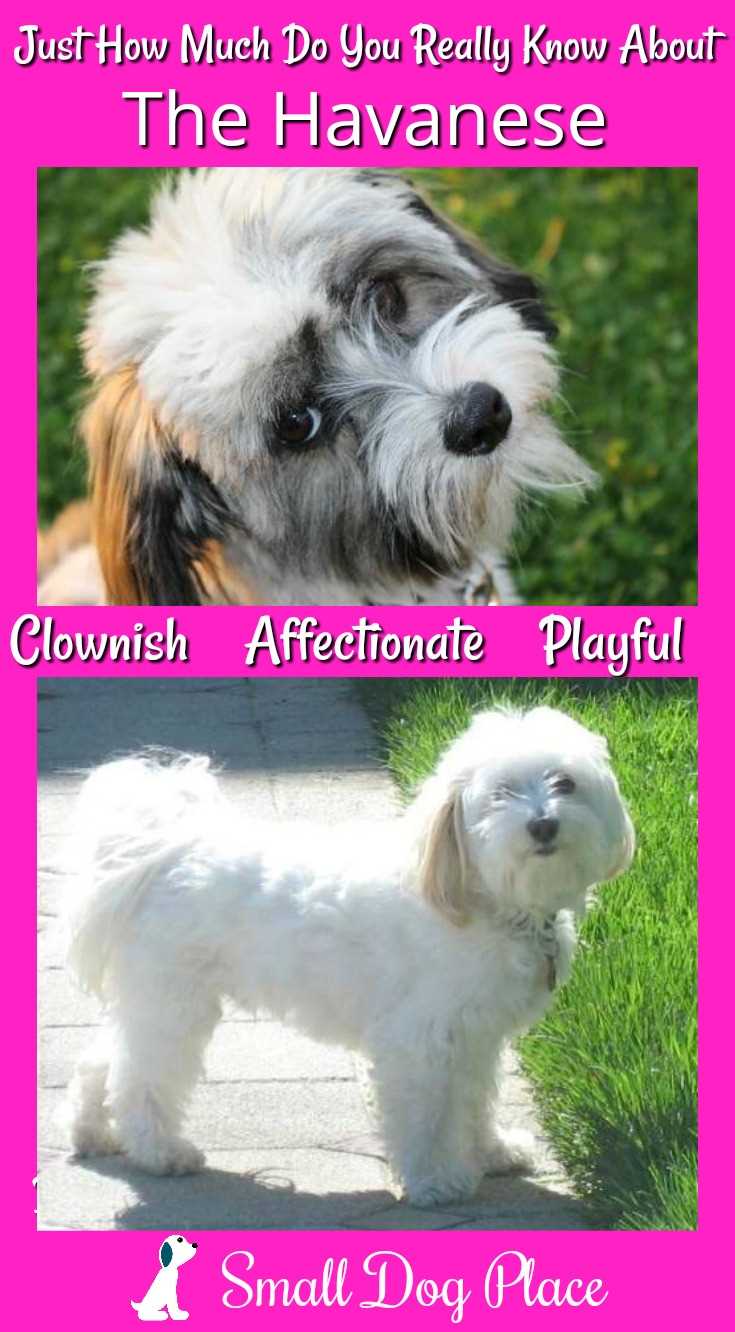The Havanese Dog
by Janice Jones |Last Updated January 24, 2020
Thinking that the Havanese Dog may be the perfect furry friend for you? Well if you’re looking for a very adaptable, amusing and overall humorous dog, then this breed could be the absolute perfect dog for you.
Even though they are a toy breed, they are fairly sturdy and not overly delicate or frail, which is a bonus especially with small kids or other pets.
These little dogs have the most adorable tiny spring in their step due to the fact that their front legs are slightly shorter than their rear legs. This gives them a little bounce, which seems to make everything they do even more amusing than it already is.
The Havanese Breed At a Glance
| Traits | Rating |
|---|---|
| Playfulness | |
| Affection Level | |
| Friendliness Towards Strangers | |
| Good with Children | |
| Good with Other Dogs | |
| Good for First Time Owners | |
| Exercise Needed | |
| Ease of Training | |
| Watch Dog Ability | |
| Grooming Requirements | |
| Shedding | |
| Cold Tolerant | |
| Heat Tolerant |
Explanations for At a Glance Ratings
- Playfulness: Most=5 Less=1
- Affection: Most=5 Least=1
- Friendliness Towards Strangers: Most=5 Least=1
- Good with Children: Good=5 Not Good=1
- Good with Other Dogs: Good=5 Not Good=1
- Good for First Time Owners: Good=5 Not Good=1
- Amount of Exercise Required: Much=5 Minimal=1
- Ease of Training: Easy=5 Difficult=1
- Watch Dog Ability: Excellent=5 Poor=1
- Grooming Needs: Extensive=5 Minimal=1
- Shedding: Heavy Shedding=5 Minimal Shedding=1
- Cold Tolerance: Cold Well Tolerated=5 Poorly Tolerated=1
- Heat Tolerance: Heat Well Tolerated=5 Poorly Tolerated=1
Another unique characteristic of the Havanese Dog is that they are not yappy or snappy like a lot of toy breeds, which makes them perfect city dogs. They will do just fine with RV or apartment dwellers.
Very similar to the Shih Tzu, the Havanese dog has an arched tail which curls over toward their back, but the tail never actually touches the back of the dog.
The breed is still considered rare, but the demand and popularity of these furry little guys is growing. Many famous people such as Queen Victoria, Charles Dickens, and Barbara Walters had a little Havanese under their care and all of them were claimed to absolutely love and adore their fur baby.
They are such a unique and at the same time very personable and fun loving dog that would make a wonderful edition to any family.
Quick Facts about the Havanese Dog
Other Names Used: Havana Silk Dog, Havanese Cuban Bichon, Bichon Havanais, Bichon Havanês, Havaneser, and Bichon Habanero
Affiliation: Toy group; AKC recognized in 1996 and CKC (Canadian Kennel Club)
Size
Height: Anywhere from 8.5 and 11.5 inches tall at the shoulder (20-28 cm)
Weight: 7-13 pounds (3 – 6 kg)
Coat Type: long, soft, lightweight, and silky; described as raw silk floss
Colors: Black, white, chocolate, silver and any combination in between including; silver, orange, fawn, cream, blue and red; All have a black nose and black pigment around the eyes, except the chocolate or brown dogs which may have a dark brown nose.
Country of Origin: Cuba
Activity Level: Moderate; routine walk needed
Life Expectancy: 14 – 15 years
Good with Children: yes, but small children should be supervised
Good with Other Pets: Yes
History of the Breed
 The Havanese Dog Breed
The Havanese Dog BreedThe Havanese dog is the national dog of Cuba, and the country's only native breed. They developed from the now extinct, Blanquito de la Habana, or “ little white dog of Havana.” It is believed that the Havana comes from an eventually crossbreed of the Blanquito and another Bichon type, including the poodle. With dedicated breeding, they are making a miraculous comeback and are quickly becoming the fastest growing breed of dog in the AKC.
For hundreds of centuries, they has adored the laps of the rich and famous. This is an ancient breed whose origins can be traced to the Mediterranean as far back as the first century A.D. These furry friends are said to be “cousins” of the Bichon family, or at least members of it.
They were also believed to have traveled among Spanish trade ships in Cuba during the early 16th century. During the Cuban Revolution, 11 Havanese dogs fled to America with their owners. That being said, all the Havanese today can be traced to 11 Havanese dog immigrants.
Personality
Since it is a toy dog, they are absolutely great to play with and surprisingly they are not too tough to train as long as they are receiving lots of positive reinforcement. They can also be house-trained, which is great for a toy breed.
Like most breeds, it is best to train when they are puppies so they do not develop bad habits when they get older. Start training right when you bring him home so he/she can soak up more information and do not give them too much freedom to roam around.
They do not become un-trainable as adults but it is just a little tougher. You do not want your little furry friend to pick up bad habits such as barking, digging or any other obnoxious activity when bored.
What they lack in size, they make up for in personality. Lively, affectionate, people loving, and compassionate, these dogs are bred for companionship.
They are best suited to indoor living, which makes them perfect city and apartment dogs. They require moderate amount of daily exercise, like most toy breeds, but will be pretty calm when taken indoors.
These little guys are very cheerful and smart, but can tend to be mischievous and occasionally naughty. Do not be surprised if you come home from work and find that your little Havanese dog tore up some newspaper or paper towels. Tearing and shredding paper is one of their favorite pastimes, so keep that in mind.
Other than their occasional mishap, they are an overall cute and fun dog and watching them play around can keep you entertained for hours. With proper training and dedication, life with a Havanese dog can be a special treat for you and everyone that gets the enjoyment of being around your new pup.
Grooming
 Grooming the Havanese
Grooming the HavaneseThe Havanese dog has a spectacular silky fur coat that can be described as raw silk fur. Unlike most double - coated coat, the fur is not coarse or overly dense, it is actually very soft and lightweight.
They have hair rather than fur, so they have little to no shedding; however they are not considered hypoallergenic by any means. They still shed dead skin cells that contain some allergens. Frequent grooming and brushing is required to brush out all the dead hair. The coat is wavy, soft and bountiful, insulating the dog from the harsh tropical rays of its native lands. The characteristic of the breed is for their hair to look messy and moppy, but some owners just prefer an overall short coat.
Their coat has a tendency to pick up dirt, grass, and debris, so keep that in mind if you let your little guy roam through the field or the backyard. Other than the typical grooming and bathing, you need to check the pads of their feet, and keep them trimmed.
Ears, nails, anal glands, and all the usual will also need to be kept in check. As with all dog whose ears drop, special care must be taken to keep the ears clean and prevent infection from setting in. The simple method of placing a cotton ball in each ear prior to bathing will help keep water from entering the ear canal. Ear hair needs to be plucked periodically.
The coat will cord naturally, or can actually be trained to cord although this look is not for everyone. The amount of grooming really depends on if you want to keep your dog’s hair long or short, but shorter is obviously less work.
Health Concerns
Havanese are considered a healthy breed, but as with other breeds there are some conditions that may come up from time to time. Some of them are considered to have an inherited basis.
They suffers primarily from luxating patella, liver disease, heart disease, cataracts, hip dysplasia, and retinal dysplasia. While not usually considered a health concern, the breed is also susceptible to tear stains especially on the white or light colored varieties.
Problems in this Breed:
Juvenile Cataracts
Did You Know?
Did you know that Barbara Walters has a little Havanese named “ Cha-Cha” and she claims that it has told her “ I love you”?
Did you know that if these dogs grow up around water, they could turn out to be excellent swimmers?
Pros:
- The Havanese is good with other people and pets; very gentle
- Loves to please people and is a great companion; strong attachment to family
- They have minimal to no shedding
- Intelligent and agile; does well in agility competitions
- Small but not yappy
- Don’t mind traveling; good for the RV lifestyle
Cons:
- Coat can tend to mat, without routine grooming
- They can get bored and love to tear up paper
- Can develop barking, digging, etc. without proper training
- Does not do well alone
The following books are available on Amazon and are recommended for further reading if you are considering the addition of a Havanese to your household.
Resources
Breed Club
About Janice (author and voice behind this site)
Having lived with dogs and cats most of her life, Janice served as a veterinary technician for ten years in Maryland and twelve years as a Shih Tzu dog breeder in Ohio.
Her education includes undergraduate degrees in Psychology with a minor in biology, Early Childhood Education, and Nursing, and a master's in Mental Health Counseling.
She is a lifelong learner, a dog lover, and passionate about the welfare of animals. Her favorite breed for over 50 years has been the Shih Tzu, but she has also lived with Poodles, Maltese, Yorkshire Terriers, Beagles, English Bulldogs, Carin Terriers, and a Cocker Spaniel.
When not writing, reading, and researching dog-related topics, she likes to spend time with her eight Shih Tzu dogs, husband, and family, as well as knitting and crocheting. She is also the voice behind Miracle Shih Tzu and Smart-Knit-Crocheting
Does This Article Deserve Your Thumbs Up?
We always appreciate your support and encouragement. Your thumbs up means so much to us. Please like this article.
If you find this page or any page on Small Dog Place Helpful, or useful in anyway, I'd love it if you would click the small heart found on the bottom right of each page.
You can also share or bookmark this page -- just click on the:

Free Monthly Newsletter
Sign Up for Our Free Newsletter and get our Free Gift to You.
my E-book, The Top 10 Mistakes People Make When Choosing a Dog (and how to avoid them)









